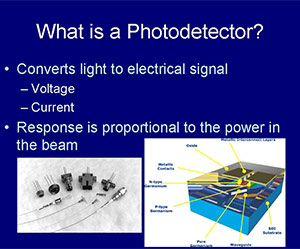Razeghi & CQD Team Conceive Advances in Photodetectors
New research by Prof. Manijeh Razeghi and her Center for Quantum Devices (CQD) team has been highlighted in an article discussing their advances in using new materials and designs for Photodetectors.
New research by Prof. Manijeh Razeghi and her Center for Quantum Devices (CQD) team has been highlighted in an article discussing their advances in using new materials and designs for Photodetectors. These improvements will make the detectors more stable and less expensive.
Excerted from an Thursday, January 29, 2015 article published by McCormick, titled, "New Infrared Photodetectors Improve Medical Screening."
 Researchers have long looked to infrared light in order to view and measure thermal energy emitted from the body. The patterns of this activity can reveal the root causes for a range of medical conditions, including headaches, allergies, liver disease, and cancer.
Researchers have long looked to infrared light in order to view and measure thermal energy emitted from the body. The patterns of this activity can reveal the root causes for a range of medical conditions, including headaches, allergies, liver disease, and cancer.
Photodetectors that can perceive more than one color are more desirable in medicine because they can lead to more accurate measurements. Although recent breakthroughs have enabled scientists to build infrared cameras that can see more than one color, or optical waveband, these types of technologies are expensive, instable, and have low uniformity for infrared with long wavelengths.
Led by Professor Manijeh Razeghi, members of Northwestern University’s Center for Quantum Devices have improved the stability and lowered the cost of mid- and long-wavelength infrared photodetectors and focal plane array cameras. They achieved this by, first, using a novel type-II superlattice material called gallium-free indium-arsenide/indium-arsenide-antimonide or mercury-cadmium-telluride material. This design can be tuned to absorb a wide range of infrared wavelengths and a number of distinct infrared bands at the same time.
“These new detectors can be used as inexpensive and robust alternatives to current infrared technologies for high-quality imaging in medical systems,” said Razeghi, Walter P. Murphy Professor of Electrical Engineering and Computer Science at the McCormick School of Engineering.
 Described in a paper published in the January 8 issue of Applied Physics Letters, the research was partially funded by DARPA, the Army Research Laboratory, the Air Force Research Laboratory, and NASA.
Described in a paper published in the January 8 issue of Applied Physics Letters, the research was partially funded by DARPA, the Army Research Laboratory, the Air Force Research Laboratory, and NASA.
Further Reading: "Razeghi Leads New Prospective Research in Surveillance & Disease Detection"
